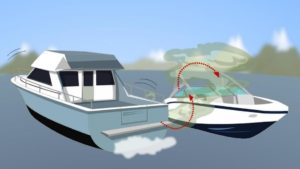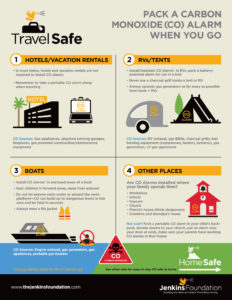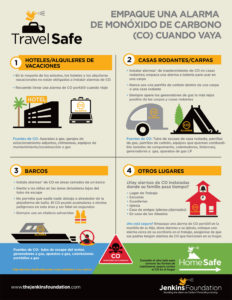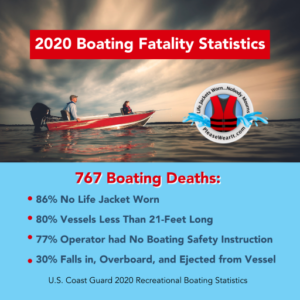Boats/Swimming
Carbon monoxide (CO) poisoning can happen aboard boats and when swimming nearby. CO is a toxic gas that is invisible and odorless - it's undetectable without an alarm. If exposure happens in the water, CO can be quickly incapacitating and lead to drowning.
Dangerous areas on the water:
☠️ In an enclosed or semi-enclosed cabin space of a boat. Equip your motorboat or houseboat with a marine carbon monoxide alarm (different than a household alarm, marine alarms are specially designed for boat environments). Sources of CO on a boat include engine exhaust, generators, space and water heaters, and cooking ranges.
- Minnesota is currently the only state in the U.S. to pass a law mandating CO alarms on boats (May 2018), their Department of Natural Resources website is a great source of information. Sophia’s Law is named for seven-year-old Sophia Baechler who died in the cabin of her parents’ boat in less than 10 minutes of exposure to carbon monoxide leaking from a hole in the boat’s exhaust pipe.
☠️ In the water near a boat while swimming, water skiing, etc. CO can linger in “pockets” near the exhaust ports even after the engine has been turned off. These toxic pockets of CO can also exist between the pontoons of boats. Many children have been poisoned in this way and have subsequently drowned due to the incapacitating effects of the CO. NEVER swim behind a running or idling boat, and always wear a life jacket.
- Utah State Parks website has additional information as well as a brochure available for download that details these risks and how to protect yourself and your family.
- The state of Washington requires any new or used motor-driven vessel, other than a Jet Ski-type personal watercraft, to display a sticker that warns passengers of the dangers of carbon monoxide (CO) poisoning.
- Effective November 2023, Andy’s Law requires boats in Oklahoma to have carbon monoxide warning stickers. The law was named for 9-year-old Andy Free who died from CO poisoning following a day of boating with his family in 2020 (Click here to listen to US Army Corps of Engineers podcast interview with Andy’s mom, Cassi Free)
☠️ On the deck of a boat in range of exhaust from that boat or from another boat nearby. Be sure your boat is at least 20 feet away from the nearest boat that is running or that has a generator running.
Stay safe:
👉 Install a marine carbon monoxide alarm and place CO warning decals in areas of risk. Decals are available to print from the U.S. Coast Guard’s website here. Use a handheld/portable CO detector to monitor CO levels in open areas of a boat.
👉 Seat children in forward areas, away from exhaust
👉 Always wear a life jacket, especially when in the water
👉 Know the symptoms of carbon monoxide poisoning, but also be aware that exposure to high levels of CO can result in loss of consciousness before any symptoms occur.
Click here to print our TravelSafe flyer (the HomeSafe side can be printed here)
Click here to print in Spanish
“It’s long been known that carbon monoxide from boat engines and generators can build up and prove deadly, inside a boat’s cabin, but it is becoming clear that this hazard also exists outside the cabin, and people are dying after being exposed to carbon monoxide in the open air”…read more in this recent ABC News story https://abcnews.go.com/WNT/story?id=129649
_______________________________________________________________________
2022 Recreational Boating Statistics
________________________________________________________________________
For more information on carbon monoxide and boating, visit the U.S. Coast Guard’s website and the U.S. Army Corps of Engineers website
Click here for a short informative video on the dangers of teak surfing.
Read stories of boating CO incidents on our newsblog
Read more about carbon monoxide here.
Additional information:
Detecting Deadly Carbon Monoxide on Boats
Today Show (video): Family shares carbon monoxide warning after daughter, 21, drowns on boat trip
Couple Spreading Awareness of Boating Dangers after Losing 7-year-old son
Mom Shares Story of 9-year-old Son’s Death as Warning
Boat-Ed.com-illustrated guide to CO danger on a boat
A Summary of Research and Progress on Carbon Monoxide Exposure Control Solutions on Houseboats, 2014
CO Hazard Mitigation Revisited (USCG, 2014)
Boating and CO Poisoning: A Dangerous Combination (USCG 2008)
CDC: Boat-related CO Poisonings – updated January 2006
CO exposure from recreational watercraft: The Tale of Two Arizona Lakes, 2003 (ppt pdf)
CO Poisoning Among Recreational Boaters (JAMA, 1995)
The Last Swim – the story of a family’s houseboat vacation turned tragic due to carbon monoxide
CDC: Houseboat-Associated Carbon Monoxide Poisonings on Lake Powell — Arizona and Utah, 2000
NIOSH Investigations and Reports – CO Dangers in Boating
Boating Safety – Carbon Monoxide (USCG, 1992)
Sources for information referenced on this page: USCG, Utah DNR State Parks, Minnesota DNR, CDC, USACE






 ...even if you don't have a boat, if your children are going on a boat with friends...make yourself aware of the risks (of CO poisoning)
...even if you don't have a boat, if your children are going on a boat with friends...make yourself aware of the risks (of CO poisoning)

